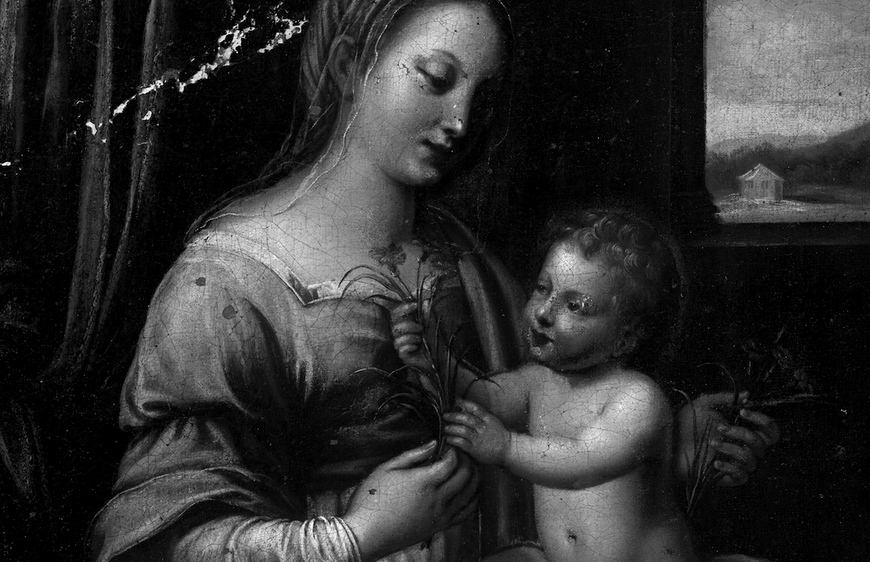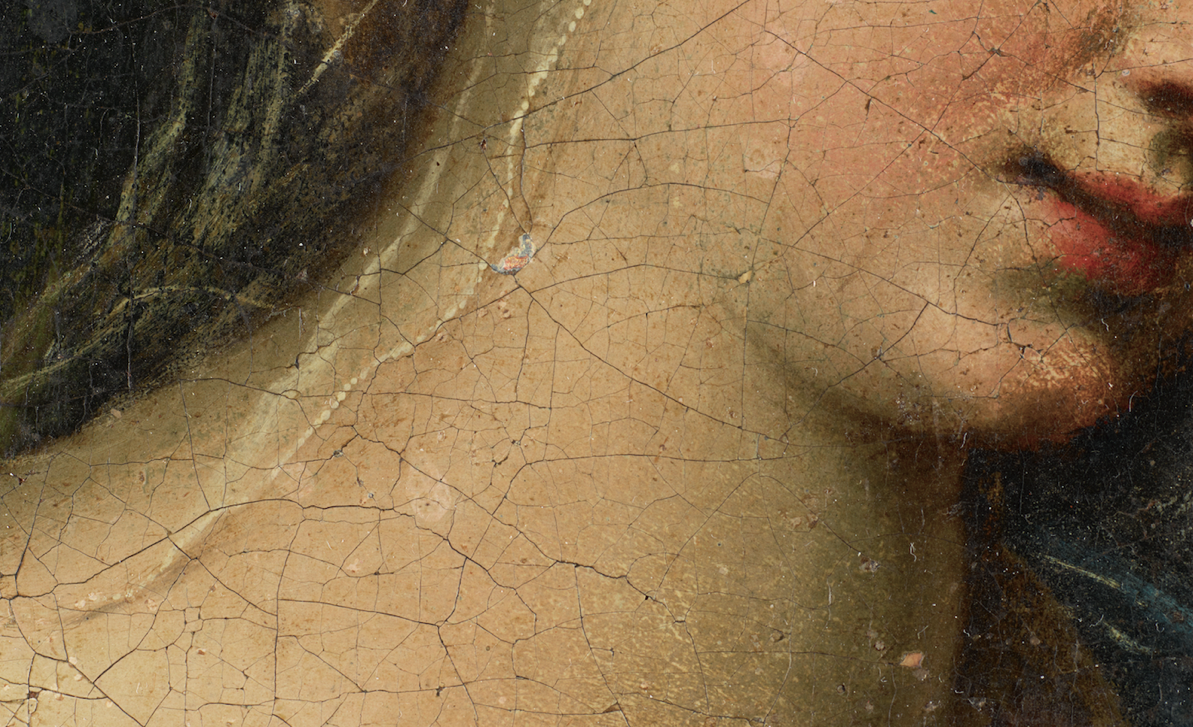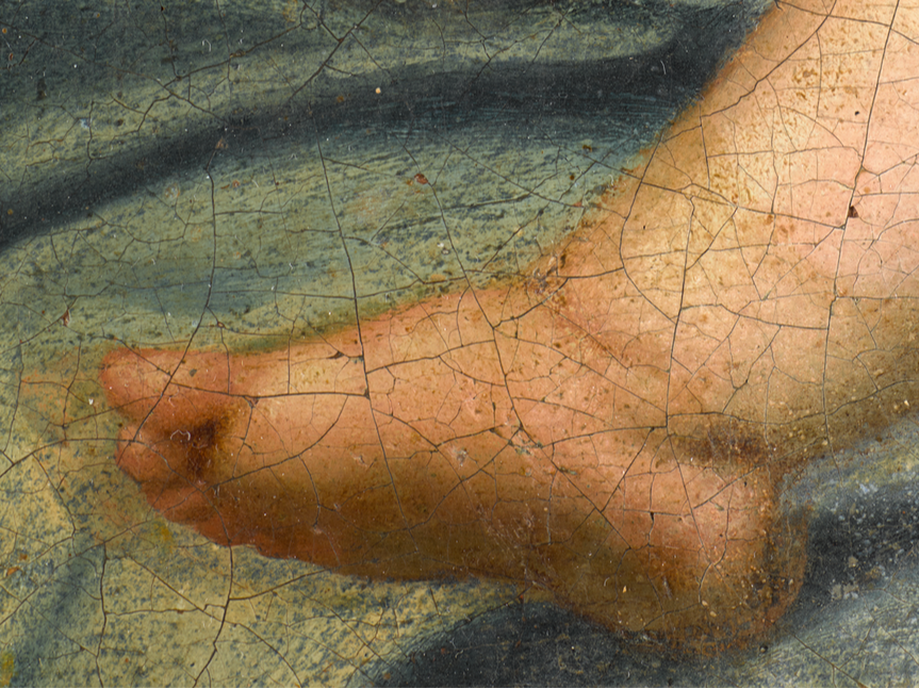|
|
(
THE CHATRON MADONNA
MATRIX (PRIME VERSION)
Raphael's Chatron Madonna dei garofani - Autograph Original (or Prime version)
(Madonna of the Pinks / Madonna of the Carnations / Madonna mit den Nelken)
Ret. Dim. : H. 56, 5 cm ; L. 48, 5 cm
(H.: 0.23 x L.: 0.2 inch)
Expertise : Dr Laure Chevalier, PhD
THE CHATRON MADONNA
MATRIX (PRIME VERSION)
Raphael's Chatron Madonna dei garofani - Autograph Original (or Prime version)
(Madonna of the Pinks / Madonna of the Carnations / Madonna mit den Nelken)
Ret. Dim. : H. 56, 5 cm ; L. 48, 5 cm
(H.: 0.23 x L.: 0.2 inch)
Expertise : Dr Laure Chevalier, PhD
Raphael's Madonna dei garofani - Autograph PRIME VERSION or Original (Madonna of the Pinks / Madonna of the Carnations)
OIL ON CANVAS
(H. 56, 5 cm ; L. 48, 5 cm)
H.: 0.23 x L.: 0.2 inch
©AGALMATA.
EXamination of the painting before restoration
Diagnosis and scientific imaging reveal, under the thick oxidized and opaque varnish, a complex implementation broken by the chemical alteration and abrasion of the pigments (especially in the copper shadows of the skin tones, or the gold of the elliptical halo which has now partially disappeared), the intervention of a second hand in the part of the blue cloak that covers the shoulder, an overpainting of "modesty" (the angle of the cushion that covers the sex of the Child painted underneath), missing scales some of which are barely visible and a state of incompleteness (the knees of the Virgin ; feet of the Child ; correction of the right arm of the Child remained visible).
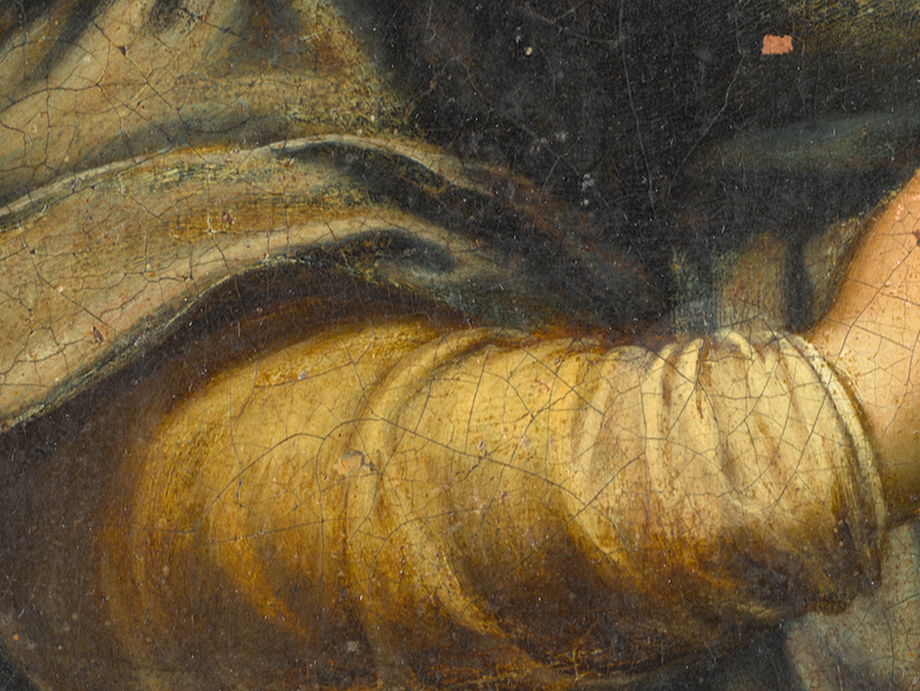
THE CHATRON MADONNA (BEFORE RESTORATION) "It's like looking at a landscape through a very dirty window" The 1957 Varnish Lightening Test (a circle on the wrist) allows to find all the freshness and the flexibility of the folds. (Compare with the rest of the sleeve where the varnish has not been lightened) ©Photography Raphaël Chipault / AGALMATA
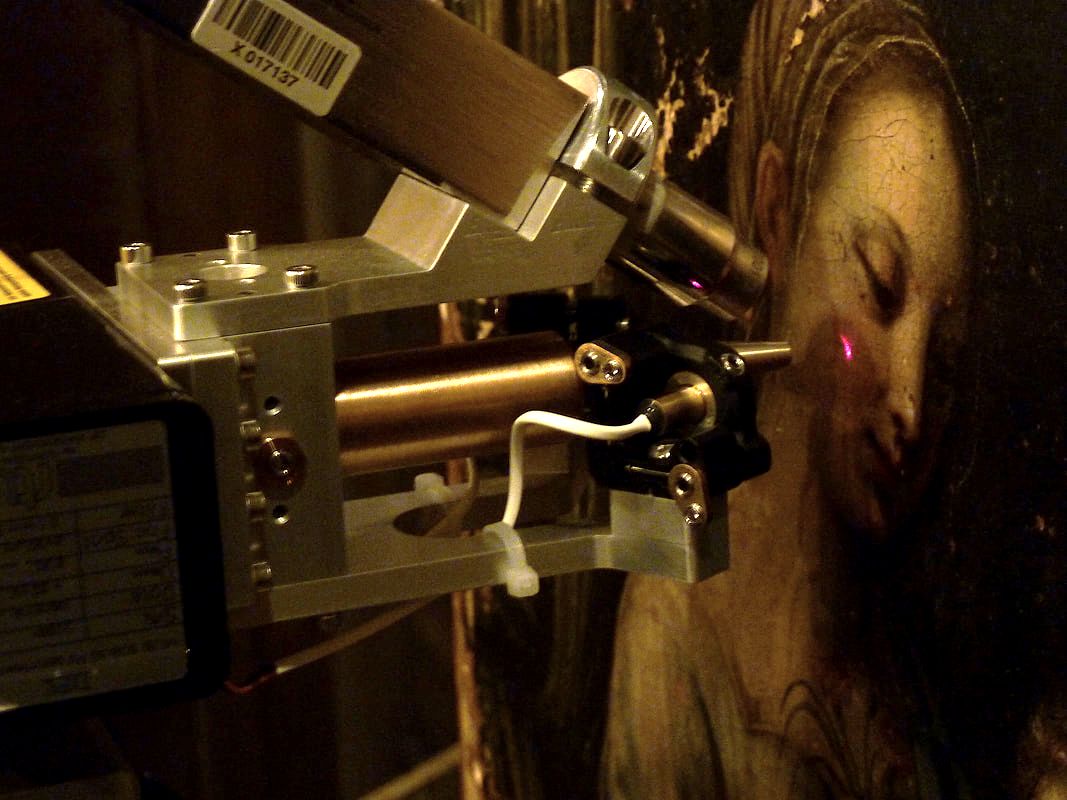
THE CHATRON MADONNA (BEFORE RESTORATION OF THE PAINTING) X-Ray fluorescence and diffraction analyses carried out by Philippe Walter director of the LAMS laboratory (CNRS / Sorbonne-University) have made it possible to characterize pigments and impurities with great precision: all the pigments are consistent with those used by Raphael Sanzio in his paintings, especially the verdigris which turned brown with time or the smalt that has become opaque.
The use of colorless powdered glass with red lake pigment (in flesh and carnations) is also well documented in Raphael Sanzio. ©AGALMATA. Fluorescence X
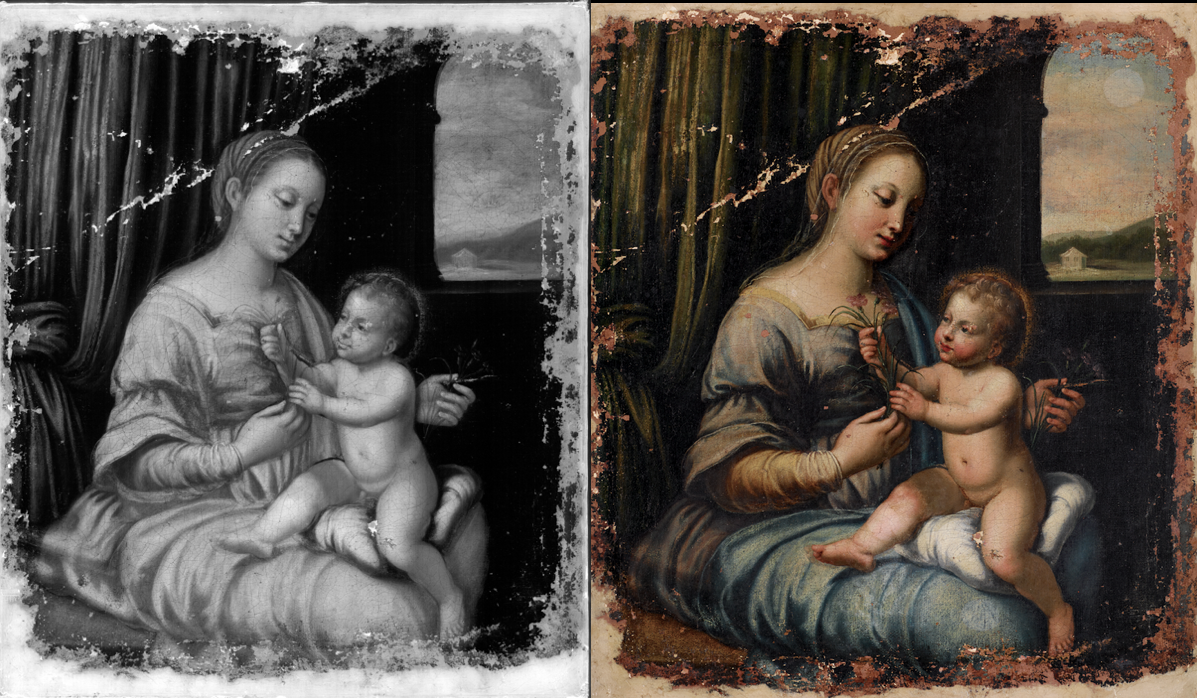
THE CHATRON MADONNA (BEFORE RESTORATION OF THE PAINTING) A slow, demanding creative process, punctuated by repentances (pentimenti) : the painter shortened the foot of the Child, refined his calf, lowered his shoulder, shortened the little fingers, modified the other fingers of the right hand, modified his hair adding curls, corrected the hands of the Virgin (shortened phalanges, softened gesture), or his thigh too long. He also regularized the oval of her face and removed a piece of her clothing (a white shirt was visible in the sleeve's indentation) and modified its mantle. As for the Child's sex, it is painted under the "overpainting of modesty" that forms the artifice of the cushion.
The generic landscape as far as the eye can see replaces the monumental construction that featured in the early phase of pictorial execution; as for the treatment of the curtain, it becomes more realistic in the final phase of Sanzio's project. On the left infrared reflectography (IR1000). ©Photography Raphaël Chipault / AGALMATA
Raphael's Unfinished Works of Florence and The Madonna "of Siena"
The Chatron Madonna - Excerpt from the Preleminary Report by Dr. Laure Chevalier (PhD)
"Vasari points out that in accepting the proposal to decorate some of the Vatican rooms, Raphael abandoned all his works in progress, especially those begun shortly before his departure for Rome (1508) which could not be completed because of the time required for their proper execution. The specialist E. Müntz also mentioned this problem of execution time with Sanzio: "There is no impartial judge who does not recognize that Raphael, even compared to his successors, was a first-rate colorist. The importance he attached to this part of the painting was such that it compromised the duration of many of his works. "The following mention allows us to appreciate the modalities of Raphael's pictorial production, in particular the simultaneous conception and execution of several paintings: Alfonso d'Este's emissary, in 1519, reports that Raphael's studio is filled with paintings in various stages of conception or execution, some of which remain for years leaning against the wall. Raphael had even left unfinished projects in Umbria and Florence, such as The Madonna of the Baldacchino, dated 1508, which remained unfinished until 1700.
In his Life of Raphael, Vasari mentions, among the Madonnas with Child executed by the Urbino master before his departure for Rome: "another (Madonna) which was later sent to Siena, and when Raphael left Florence, was given to Ridolfo del Ghirlandaio to finish the blue drapery. In his Life of Ridolfo, David and Benedetto Ghirlandaio, Vasari returns to this episode and specifies: "[...] Raphael, obliged to go to Rome at the call of Julius II, entrusted him [i.e. Ridolfo del Ghirlandaio] with the task of finishing the blue drapery and some small things that were missing from a Madonna commissioned by Sienese gentlemen. The painting, completed by Ridolfo with great diligence, was sent to Siena. "This testimony by Vasari deserves our full attention, albeit with the necessary reservations given the decades that separate Le vite de' più eccellenti pittori, scultori, e architettori from the facts he reports.
This painting by Raphael cited by Vasari remains to be identified among the Madonnas with Child of the master, due to the lack of material correspondence in the works already analyzed (lack of heterogeneity in the pictorial technique in the execution of the blue drapery). For a long time, it has been assimilated to La Belle Jardinière, signed and dated 1508; but as physical-chemical examinations have revealed the homogeneity of the blue drapery, the painting in the Louvre cannot correspond. The Madonna Colonna from Berlin has also been proposed, precisely because of its unfinished nature. But here too, studies have shown the homogeneity of the blue draperies.
The date of execution assigned to Raphael's Madonna of the Carnations (Madonna dei Garofani), which generally fluctuates between 1506 and 1508, invites questions about its case, and its possible correspondence with the painting mentioned by Vasari.
Precisely, a plethora of clues lead to the recognition of the Madonna dei Garofani in the "Madonna of Siena" that Raphael would have entrusted, according to Vasari, to Ridolfo del Ghirlandaio in 1508 "to finish the blue drapery and a few other things that were missing", and which was "subsequently sent to Siena", then under French influence (Duchy of Milan):
"For the painting, I have not done anything exceptional and I will not do it if I can, because it is better that I estimate it beforehand, and I have not written what I cannot write about it, and I cannot tell you about it yet; but according to the commissioner of the painting, he says he will give me work for about three hundred gold ducats for here and for France. When the festivities are over, I may write to you about what the painting will be, for I have finished the cartoon, and I will be back to work at Easter."
(Raffaello Sanzio, letter of April 28, 1508)
I maintain that the proposal to identify The Madonna dei Garofani with the "Madonna of Siena" is all the more relevant since the scientific analysis of The Chatron Madonna has revealed the heterogeneity of the blue mantle of the Virgin ... Precise point on which scholars agree to recognize the material evidence corresponding to the painting entrusted by the master of Urbino to Ridolfo del Ghirlandaio in 1508. On the one hand, the diagnosis of The Chatron Madonna has revealed significant material evidence of an autograph invention consistent with the date of pictorial execution of the motif (1508 - ); on the other hand, two distinct styles have appeared in the precious ultramarine spreads of the mantle of The Chatron Madonna.
This new lead from Siena is decisive in that it leads to the precise identification of a work by Raphael Santi that had previously been lost. "
`Dr Laure Chevalier (Ph.D)
"Vasari points out that in accepting the proposal to decorate some of the Vatican rooms, Raphael abandoned all his works in progress, especially those begun shortly before his departure for Rome (1508) which could not be completed because of the time required for their proper execution. The specialist E. Müntz also mentioned this problem of execution time with Sanzio: "There is no impartial judge who does not recognize that Raphael, even compared to his successors, was a first-rate colorist. The importance he attached to this part of the painting was such that it compromised the duration of many of his works. "The following mention allows us to appreciate the modalities of Raphael's pictorial production, in particular the simultaneous conception and execution of several paintings: Alfonso d'Este's emissary, in 1519, reports that Raphael's studio is filled with paintings in various stages of conception or execution, some of which remain for years leaning against the wall. Raphael had even left unfinished projects in Umbria and Florence, such as The Madonna of the Baldacchino, dated 1508, which remained unfinished until 1700.
In his Life of Raphael, Vasari mentions, among the Madonnas with Child executed by the Urbino master before his departure for Rome: "another (Madonna) which was later sent to Siena, and when Raphael left Florence, was given to Ridolfo del Ghirlandaio to finish the blue drapery. In his Life of Ridolfo, David and Benedetto Ghirlandaio, Vasari returns to this episode and specifies: "[...] Raphael, obliged to go to Rome at the call of Julius II, entrusted him [i.e. Ridolfo del Ghirlandaio] with the task of finishing the blue drapery and some small things that were missing from a Madonna commissioned by Sienese gentlemen. The painting, completed by Ridolfo with great diligence, was sent to Siena. "This testimony by Vasari deserves our full attention, albeit with the necessary reservations given the decades that separate Le vite de' più eccellenti pittori, scultori, e architettori from the facts he reports.
This painting by Raphael cited by Vasari remains to be identified among the Madonnas with Child of the master, due to the lack of material correspondence in the works already analyzed (lack of heterogeneity in the pictorial technique in the execution of the blue drapery). For a long time, it has been assimilated to La Belle Jardinière, signed and dated 1508; but as physical-chemical examinations have revealed the homogeneity of the blue drapery, the painting in the Louvre cannot correspond. The Madonna Colonna from Berlin has also been proposed, precisely because of its unfinished nature. But here too, studies have shown the homogeneity of the blue draperies.
The date of execution assigned to Raphael's Madonna of the Carnations (Madonna dei Garofani), which generally fluctuates between 1506 and 1508, invites questions about its case, and its possible correspondence with the painting mentioned by Vasari.
Precisely, a plethora of clues lead to the recognition of the Madonna dei Garofani in the "Madonna of Siena" that Raphael would have entrusted, according to Vasari, to Ridolfo del Ghirlandaio in 1508 "to finish the blue drapery and a few other things that were missing", and which was "subsequently sent to Siena", then under French influence (Duchy of Milan):
- Ridolfo Ghirlandaio is the author of a very precise pictorial quote of the motif of Raphael's Madonna of the Carnations [wrongly called Madonna of the Pinks], when he painted, around 1525, the altarpiece of the church of the Holy Spirit in Prato (Chiesa del Sancto Spirito). With the exception of the position of one hand, his Christ conforms to the Child as depicted on the Madonna Chatron (the shortening of his right foot is exact, and the hair is curled).
- The Sienese painter Domenico Mecharino, known as Beccafumi, twice borrowed La Madonna dei Garofani from the Sanzio - which he saw in Siena: his first quotation is the Madonna with Child kept in the Pinacoteca dell'Académia di Carrara in Bergamo; the second, his Holy Family with St. John the Baptist Child and a donor dated 1528 and kept in the Horne Foundation Museum in Florence (inv. 6523 [1916/1936]).
- [...]
- The author of one of the oldest known replicas of the Madonna dei Garofani, Archita Ricci, practiced in Umbria, in the province of Perugia, not far from Siena.
- Francesco Vanni, a painter and engraver of the Sienese school, borrowed from Raphael the features of the Madonna of the Carnations (Madonna dei Garofani) in his Madonna of the Holy Family (Museum of Fine Arts, Budapest, Esterházy Collection).
- The French provenance, or that of Italian cities under French influence (the Duchy of Milan and related cities), of all the earliest known replicas of Raphael's Madonna dei Garofani reinforces the Sienese connection, as the city was under French rule until 1525.
- Finally, the link between Raphael, France, and hence the areas of the Italian peninsula under French rule is perfectly assured, as early as the spring of 1508: Raphael himself mentions the orders for 300 gold ducats, which were made to him "for here and for France," in his letter of April 28, 1508, which he addressed from Florence to his uncle, Simone de Batista di Ciarla da Urbino:
"For the painting, I have not done anything exceptional and I will not do it if I can, because it is better that I estimate it beforehand, and I have not written what I cannot write about it, and I cannot tell you about it yet; but according to the commissioner of the painting, he says he will give me work for about three hundred gold ducats for here and for France. When the festivities are over, I may write to you about what the painting will be, for I have finished the cartoon, and I will be back to work at Easter."
(Raffaello Sanzio, letter of April 28, 1508)
I maintain that the proposal to identify The Madonna dei Garofani with the "Madonna of Siena" is all the more relevant since the scientific analysis of The Chatron Madonna has revealed the heterogeneity of the blue mantle of the Virgin ... Precise point on which scholars agree to recognize the material evidence corresponding to the painting entrusted by the master of Urbino to Ridolfo del Ghirlandaio in 1508. On the one hand, the diagnosis of The Chatron Madonna has revealed significant material evidence of an autograph invention consistent with the date of pictorial execution of the motif (1508 - ); on the other hand, two distinct styles have appeared in the precious ultramarine spreads of the mantle of The Chatron Madonna.
This new lead from Siena is decisive in that it leads to the precise identification of a work by Raphael Santi that had previously been lost. "
`Dr Laure Chevalier (Ph.D)

